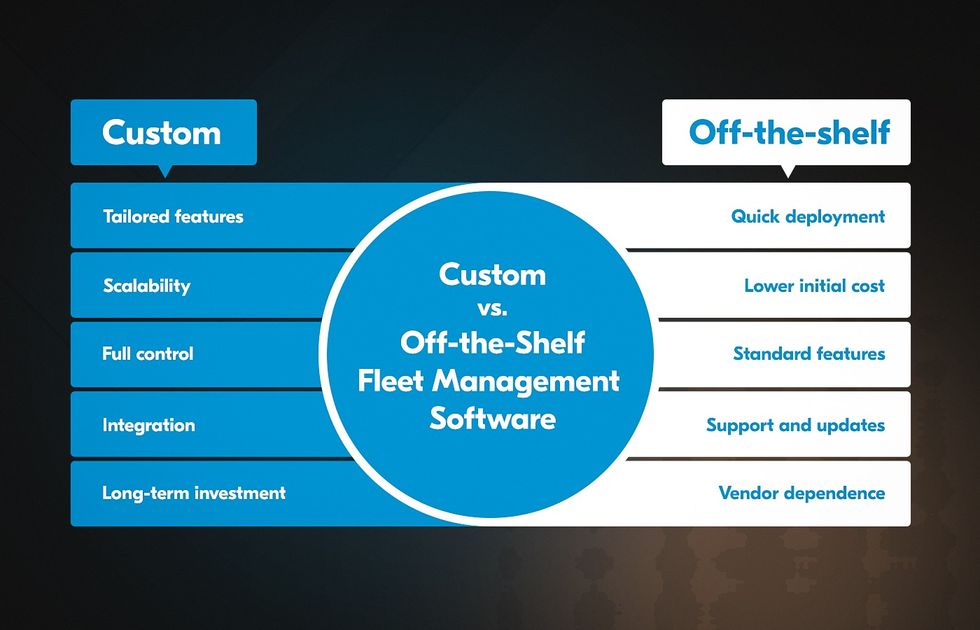
Key Takeaways
- A fleet management system caters to companies that own and operate their vehicles, focusing on tracking, route optimization, maintenance scheduling, and fuel consumption monitoring.
- Custom fleet management software development addresses the unique needs of a transportation company, where the functionality is tailored to specific vehicle management operations.
- The fleet management software market is projected to grow from $23.88B in 2023 to USD 50.36B by 2028 at a 16.09% CAGR.
Managing a fleet of commercial vehicles means juggling numerous tasks and bearing enormous responsibility. And it doesn’t get easier with external factors like the shifting car market and industry trends, legislation changes, and ballooning costs. However, what could make a difference is a custom fleet management and tracking solution.
Through years of logistics software development at Acropolium, we understand the difficulty of coordinating fleet management activities. We also know that the right software can help you improve operational efficiencies, increase the lifecycle of vehicles, and maintain compliance.
That’s why we advocate for a system that enhances the productivity of your fleet while reducing expenses. We’re here to help you understand the process of fleet management software development and remove productivity bottlenecks based on the real-life logistics solutions we’ve built since 2013.
Global Fleet Management Software Market

Businesses in every industry aim to enhance operational efficiency, reduce costs, and improve productivity. Utilizing fleet management software, companies can streamline fleet operations, optimize routes, and manage resources efficiently. Thus, the fleet management software market is forecasted to expand from $23.88B in 2023 to USD 50.36B by 2028, exhibiting a 16.09% CAGR.
Use Cases of Fleet Management Software

Let’s start with the use cases and tech trends that will guide fleet management in the near future. We’re focusing on them to help you decide on the functions for improved driver safety, supply chain visibility, asset tracking, and fleet coordination you’ll want in your truck fleet management software.
Remote Fleet Management
The Covid-19 pandemic set new standards of remote work arrangements. Many fleet management companies carry on with the remote work set-up to automate workflows and hence save money.
To ensure successful remote fleet monitoring and management, you need to be equipped with software for fleet maintenance that provides real-time visibility across operations. This will help you stay in contact with the teams and effectively monitor tasks, increasing productivity.
Telematics Tracking

Monitoring and communicating driver behavior, location, fuel consumption, and other data helps telematics devices improve the efficiency of fleet operations. By including telematics in your fleet tracker software development process, you can centralize and improve the visibility of fleet data. This will allow you to automatically record vehicle data, receive fault alert notifications, and sync odometer readings.
Artificial Intelligence (AI)
Fleet management companies can use artificial intelligence for real-time fleet analytics and logistics chatbots, optimizing repair and maintenance decisions, and streamlining recruitment. But most importantly, the adoption of AI-powered fleet management systems increases drivers’ safety without compromising efficiency.
AI and blockchain-based applications offer many use cases like handling driver coaching, road risk data analysis, and route recommendations. Additionally, they help managers, mechanics, and fleet drivers make data-based decisions that improve fleet performance.
Big Data and 5G
Before long, 5G will be the global wireless standard for mobile devices. Increasing the speed of information transfer, it will boost productivity, reduce latency, and improve team connectivity for fleet management businesses.
The technology’s speed will also boost the use of big data for improved decision-making when it comes to preventative maintenance, fuel use, route information, and other daily operations.
The Internet of Things (IoT)
The integration of IoT into fleet management software allows collection of real-time engine data, fuel data, driver location, and auxiliary data. By providing enough information to be analyzed, IoT can help streamline freight forwarding and optimize many functions in the fleet ecosystem, decrease emissions, improve compliance, and enhance customer satisfaction.
Fleet Management Software Must-have Features

Before you develop a fleet management system, make sure to discuss its functions with your development team. The right fleet management system should at least have features to increase performance and productivity. What’s more, these functions should differ for managers and drivers:
Fleet Management System Features for Managers
Managers can stay on top of fleet operations by tracking crucial details about employees, vehicles, and equipment.
Dispatch management
Offering fleet visibility, your management platform must contain dispatching functionality to track vehicles, save fuel, and boost profits. Dispatchers should have the ability to view all vehicles in the fleet on one map and assign the driver closest to the destination. The improved dispatching process will reduce off-hours driving and idle time.
Fuel management
Enhanced by fuel card integration, this management system lets you check purchases in real-time, track consumption, and prevent the misuse of fuel cards. It allows cross-checking fuel data with driver behavior data, setting targets, and providing eco-driving training.
Order and inventory management
An order management module offers a hub that weaves together workflows like purchase orders, equipment inventory, warehouse inventory visibility, and customer billing tracking. You get a powerful control center that lets you manage fleet operations more efficiently.
VIN lookup
A vehicle identification number (VIN) decoder within a fleet management solution allows you to quickly access vehicle details and specifications. The information can help fleet managers properly identify vehicles and replace the assets as needed or when the fleet grows in size.
Instead of typing in numerous data points like the model, performance specs, and make of the vehicle, you can use the decoder to populate the data fields with a click of a button.
Fleet Management System Features for Drivers

Allow technology to reduce human errors and improve productivity with the following fleet management software features for drivers.
Routing
With route optimization tools integrated into your fleet management system, drivers can follow pre-scheduled routes that increase efficiency while reducing costs. The fleet managers can later check if the driver followed the suggested route and determine productivity accordingly.
Mileage tracking and fuel monitoring
To simplify log management, GPS-tracking features capture the miles or distance driven. Drivers are provided with 24/7 access to tools that make day-to-day odometer tracking and monthly mileage reporting more convenient. And detailed mileage reports can be sent directly to the payroll department. A fuel monitoring feature tracks and records fuel consumption, providing insights into fuel usage patterns, identifying inefficiencies, and helping to optimize fuel efficiency.
Communication
An in-app chat with live driver status updates and notifications will bring transparency into the vehicle’s movement while allowing drivers to focus on the road. Two-way communication between drivers and dispatchers for updates, instructions, and emergencies in a fleet management system will create a more seamless workflow for both parties.
Fleet Maintenance Software Must-Have Features

Creating fleet maintenance software will help you prevent liabilities and resolve issues. Here are the functions you’ll need to run a smooth-sailing fleet, both from the management and drivers’ perspective:
Fleet Maintenance Software Features for Managers
By having specialized software for fleet maintenance, fleet managers can automate maintenance alerts, handle service, and resolve issues within a centralized system. Inventory management To make sure you’ll never run out of parts, stock-level alerts let you know when it’s time to reorder. You can also match invoices with purchase orders to stay organized. Adding the parts to work orders will allow you to track their usage and keep stock levels updated. The system can also be integrated with other shipping tools to make reordering convenient.
Preventive maintenance scheduling

Your system must be able to forecast the need for wheel alignments, oil changes, brake maintenance, and other regular service items. You can use your fleet maintenance software to monitor usage and costs at the vehicle system and service task levels. The data can be used to set maintenance schedules and service reminders.
Fleet Maintenance Software Features for Drivers
These features prompt drivers to increase productivity while staying safe.
Incident reporting
An in-vehicle AI can be used to detect incidents and capture relevant video and pertinent information like time and location. Such fleet maintenance software features can automatically furnish incident reports for reliable claims resolutions. Gathered information and documentation can reduce the cost of injury, prevent potential liability, and combat frivolous claims.
Inspection management
An electronic inspection system can help you maintain airtight compliance and improve risk management. Drivers record inspection results in an app or web browser, after which the fleet manager can schedule repairs. The driver can mark the issue as resolved after the repairs are completed. The road-ready vehicle will then operate with a compliant inspection report.
Fleet Management Software: Custom vs. Off-the-Shelf

Custom and ready-made fleet management solutions offer distinct approaches to managing and optimizing fleets, each with its own set of characteristics and considerations.
Custom Fleet Management Systems
Custom tools are tailored solutions developed specifically to meet the unique needs and requirements of a particular fleet operation, offering numerous fleet management system benefits:
- Tailored features. Custom solutions are designed and developed from the ground up to meet a particular fleet operation’s unique needs and workflows.
- Scalability. They can be scaled to accommodate the growth and changing requirements of the fleet, offering flexibility and adaptability.
- Full Control. Businesses have complete control over the features, functionalities, and user interface of the solution, allowing for a personalized and intuitive user experience.
- Integration. Custom solutions can seamlessly integrate with existing systems like transportation management tools and processes, such as inventory management or dispatch software.
- Long-term investment. While the initial development cost may be higher, custom solutions often result in lower long-term costs, eliminating the need for ongoing licensing fees and customization of off-the-shelf software.
Off-the-Shelf Fleet Management Systems
Ready-made fleet management tools are pre-built software packages readily available for purchase or subscription. They provide standard features with few customization opportunities:
- Quick Deployment. Such tools can be deployed rapidly, saving time and resources compared to custom development.
- Lower Initial Cost. Ready-made solutions typically have lower upfront costs since development and maintenance expenses are spread across multiple users.
- Standard Features. Off-the-shelf fleet tools come with standard features and functionalities that may meet the basic needs of fleet operations without requiring customization.
- Support and Updates. Providers of ready-made solutions often offer ongoing support, maintenance, and updates, reducing the burden on internal IT teams.
- Vendor Dependence. Businesses relying on ready-made solutions are dependent on the vendor for updates, support, and customization. This can sometimes lead to issues if the vendor stays out of business or continues product support.
Now that you’ve selected the features you’d like your system to have, it’s time to actually build the vehicle fleet management software.
Custom Fleet Management Software Development

Fleets depend on technology for effective communication, data analytics, and management of resources and teams. But what goes into building a fleet management system?
Critical Components of Fleet Management Software Solutions
Your custom fleet management system must be complete with the following basic components:
Telematics and IoT sensors
Telematics allows the software to record a vehicle’s exact location and speed while traveling on the road at any given time. It integrates diagnostic IoT sensors and GPS navigation. The system may also provide advanced insights like tailgating alerts and turn and braking metrics.
Maintenance planning
To avoid compliance issues, your fleet management software should automate vehicle maintenance schedules and provide service alerts. This will help you ensure your vehicles remain operationally sound.
Parts management and warranty tracking
Although laborious and time-intensive, effective parts management is crucial to the success of a large fleet. Your fleet management software should provide an automated and streamlined approach to tracking replacement parts and warranties.
When building a custom fleet management solution, don’t forget it should also include a simple user interface (UI), multi-platform support, and security features.
Compliance and security
Fleet management systems have to ensure compliance with regulations on driver hours, inspections, weight limits, and hazardous materials. Some solutions integrate Electronic Logging Devices (ELDs) to record drivers’ hours to meet FMCSA rules. If you decide to develop your own fleet tool, you can also add features to track driver training and incidents for legal compliance and prevention.
Steps of The Development Process
The development of your fleet management software requires thorough planning, project estimation, and diligent execution. It involves the following steps:
- Putting together a team of experienced UI/UX designers, engineers, testers, and managers.
- Creating a Minimum Viable Product (MVP) and testing it against a small audience.
- Adding functions based on user feedback.
- Launching the application.
All the details will depend on whether the app is going to be web-based or mobile, native or cross-platform, available to both drivers and managers or just managers, and many more.
How to Make a Fleet Management System Scalable and Cost-effective

To keep up with the growing demand in a competitive industry, your software must be easily scalable. This, of course, means that your system’s architect needs to think of scalability before product development and design the system accordingly:
- Try tapping into the benefits of cloud-based solutions. Taking your system to the cloud allows for better system integration, increased speed of data downloads, enhanced remote processing of data and transactions, and mobile-centric operations—all while reducing costs.
- Choose the right technology. The right technology stack will take you a long way (transportation pun intended), but only if it’s carefully selected by an experienced team.
- Check the vendor’s reputation. Ask if they’ve already developed similar fleet management applications for other clients. If so, they’ve probably also tried out different tools and narrowed their selection down to the most effective ones. Most fleet management solutions are built using Node.js, MongoDB, Vue.js, React Native (for mobile apps), and many other frameworks, languages, and environments.
Acropolium’s Experience
At Acropolium, we understand that fleet management is more than just about record keeping. You need a solution to connect fleet managers, drivers, owners, vendors, admins, and technicians to reduce downtime and minimize profit loss.
Our experienced engineers can create fleet management software that seamlessly integrates real-time GPS tracking, vehicle diagnostics, driver safety monitoring, route optimization, and fuel management. During our recent cooperation with a logistics company, we developed a SaaS-based fleet management system that automated routine business tasks. The solution reduced delivery time by 31% and fuel consumption by 14%, boosting the client’s efficiency.
Don’t hesitate to contact Acropolium and discover how we can make your fleet more efficient and profitable!









![Transportation Telematics System: [Benefits, Challenges & Use Cases]](/img/articles/the-power-of-telematic-systems-in-transportation-benefits-challenges-and-use-cases/img01.jpg)
![Blockchain for Supply Chain Management: [Benefits & Use Cases]](/img/articles/why-and-how-to-employ-blockchain-in-supply-chain-management-tips-and-success-stories/img01.jpg)
![Cloud Computing in Logistics and Supply Chain [2025 Guide]](/img/articles/cloud-computing-in-logistics-and-supply-chain/img01.jpg)
![Best Trucking Software in 2025: [Custom or Off-The-Shelf]](/img/articles/best-trucking-software-to-consider-custom-vs-off-the-shelf/img01.jpg)
![ᐉ Airport Operations Management Solftware [2025 Guide]](/img/articles/airport-operations-management/img01.jpg)
![The Best Route Optimization Software to Employ in [2025]](/img/articles/route-optimization-software/img01.jpg)